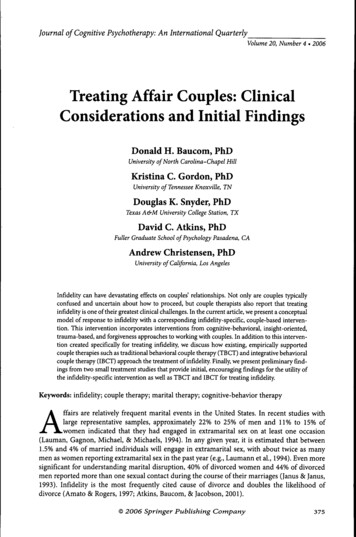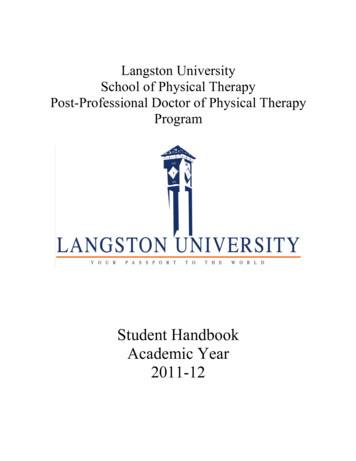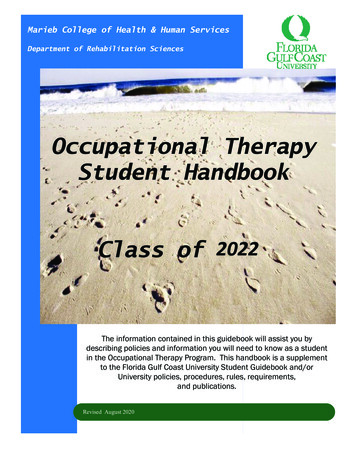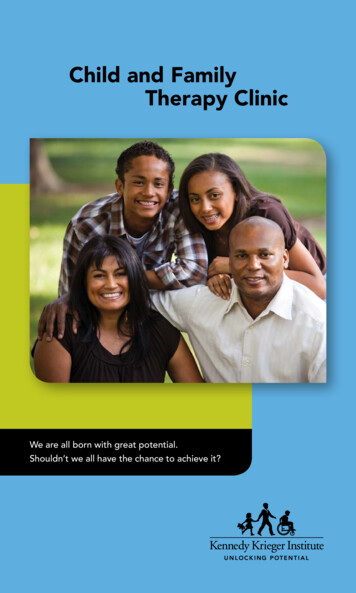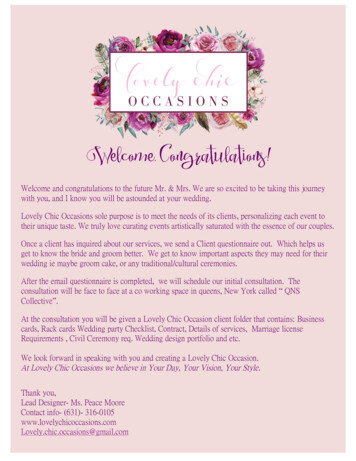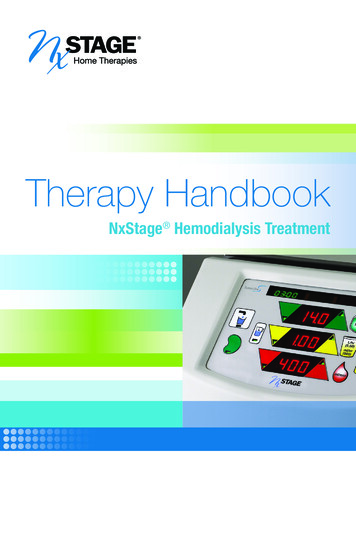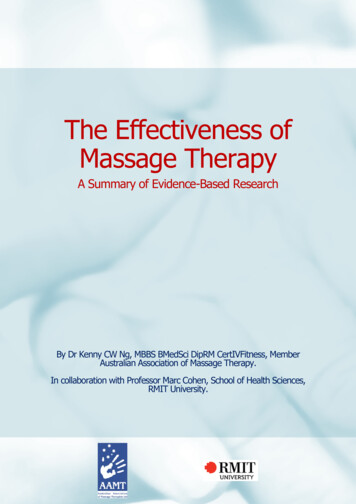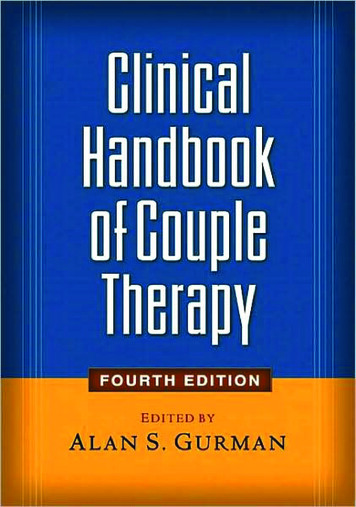
Transcription
Clinical Handbook of Couple Therapy
ClinicalHandbookof CoupleTherapyFourth EditionEdited byALAN S. GURMANTHE GUILFORD PRESSNew York London
2008 The Guilford PressA Division of Guilford Publications, Inc.72 Spring Street, New York, NY 10012www.guilford.comAll rights reservedNo part of this book may be reproduced, translated, stored in a retrieval system, or transmitted, in any formor by any means, electronic, mechanical, photocopying, microfilming,recording, or otherwise, without written permission from the Publisher.Printed in the United States of AmericaThis book is printed on acid-free paper.Last digit is print number: 987654321The authors have checked with sources believed to be reliable in their efforts to provide information that iscomplete and generally in accord with the standards of practice that are accepted at the time of publication.However, in view of the possibility of human error or changes in medical sciences, neither the authors, northe editor and publisher, nor any other party who has been involved in the preparation or publication of thiswork warrants that the information contained herein is in every respect accurate or complete, and they arenot responsible for any errors or omissions or the results obtained from the use of such information. Readersare encouraged to confirm the information contained in this book with other sources.Library of Congress Cataloging-in-Publication DataClinical handbook of couple therapy / edited by Alan S. Gurman.—4th ed.p. ; cm.Includes bibliographical references and index.ISBN 978-1-59385-821-6 (hardcover : alk. paper)1. Marital psychotherapy—Handbooks, manuals, etc. I. Gurman, Alan S.[DNLM: 1. Marital Therapy—methods. 2. Couples Therapy—methods. WM 430.5.M3 C641 2008]RC488.5.C584 2008616.89′1562—dc222008010079
To Jim Framo, Cliff Sager, and Robin Skynner—who understood a thing or two about couples,and, of course, to Neil Jacobson—who is still a part of this
About the EditorAlan S. Gurman, PhD, is Emeritus Professor of Psychiatry and Director of Family Therapy Trainingat the University of Wisconsin School of Medicine and Public Health. He has edited and writtenmany influential books, including Theory and Practice of Brief Therapy (with Simon H. Budman), theHandbook of Family Therapy (with David P. Kniskern), and Essential Psychotherapies (with Stanley B.Messer). A past two-term Editor of the Journal of Marital and Family Therapy and former President ofthe Society for Psychotherapy Research, Dr. Gurman has received numerous awards for his contributions to marital and family therapy, including awards for “Distinguished Contribution to Researchin Family Therapy” from the American Association for Marriage and Family Therapy, for “Distinguished Achievement in Family Therapy Research” from the American Family Therapy Academy,and for “Distinguished Contributions to Family Psychology” from the American Psychological Association. More recently, he received a national teaching award from the Association of PsychologyPostdoctoral and Internship Centers for “Excellence in Internship Training/Distinguished Achievement in Teaching and Training.” A pioneer in the development of integrative approaches to coupletherapy, Dr. Gurman maintains an active clinical practice in Madison, Wisconsin.vii
ContributorsDonald H. Baucom, PhD, Professor, Psychology Department, University of North Carolina–ChapelHill, Chapel Hill, North CarolinaSteven R. H. Beach, PhD, Professor, Department of Psychology, and Director, Institute of BehavioralResearch, University of Georgia, Athens, GeorgiaGary R. Birchler, PhD, Retired, formerly Clinical Professor of Psychiatry, University of California–San Diego, San Diego, CaliforniaNancy Boyd-Franklin, PhD, Professor, Graduate School of Applied and Professional Psychology,Rutgers, The State University of New Jersey, New Brunswick, New JerseyJames H. Bray, PhD, Associate Professor, Departments of Family and Community Medicine andPsychiatry, Baylor College of Medicine, Houston, TexasAndrew Christensen, PhD, Professor, Department of Psychology, University of California–LosAngeles, Los Angeles, CaliforniaAudrey A. Cleary, MS, PhD candidate, Department of Psychology, University of Arizona, Tucson,ArizonaGene Combs, MD, Director of Behavioral Science Education, Loyola/Cook County/Provident HospitalCombined Residency in Family Medicine, Chicago, IllinoisSona Dimidjian, PhD, Assistant Professor, Department of Psychology, University of Colorado–Boulder,Boulder, ColoradoLee J. Dixon, MA, PhD candidate, Department of Psychology, University of Tennessee–Knoxville,Knoxville, TennesseeJessica A. Dreifuss, BS, PhD candidate, Department of Psychology, University of Georgia, Athens,GeorgiaJennifer Durham, PhD, President, Omolayo Institute, Plainfield, New JerseyNorman B. Epstein, PhD, Professor, Department of Family Science, and Director, Marriage and FamilyTherapy Program, University of Maryland–College Park, College Park, Marylandix
xContributorsWilliam Fals-Stewart, PhD, Director, Addiction and Family Research Group, and Professor, School ofNursing, University of Rochester, Rochester, New YorkBarrett Fantozzi, BS, PhD candidate, and Research Coordinator, DBT Couples and Family TherapyProgram, Department of Psychology, University of Nevada–Reno, Reno, NevadaKameron J. Franklin, BA, PhD candidate, Department of Psychology, University of Georgia, Athens,GeorgiaJill Freedman, MSW, Director, Evanston Family Therapy Center, Evanston, IllinoisAlan E. Fruzzetti, PhD, Associate Professor and Director, Dialectical Behavior Therapy and ResearchProgram, Department of Psychology, University of Nevada–Reno, Reno, NevadaBarbara Gabriel, PhD, Research Scholar, Graduate Study Research Center, University of Georgia,Athens, GeorgiaKristina Coop Gordon, PhD, Associate Professor, Department of Psychology, University of Tennessee–Knoxville, Knoxville, TennesseeMichael C. Gottlieb, PhD, FAFP, Clinical Professor, Department of Psychiatry, University of TexasHealth Science Center, Dallas, TexasJohn Mordechai Gottman, PhD, Emeritus Professor, Department of Psychology,University of Washington, and Director, Relationship Research Institute, Seattle, WashingtonJulie Schwartz Gottman, PhD, Cofounder and Clinical Director, The Gottman Institute, andCofounder and Clinical Director, Loving Couples/Loving Children, Inc., Seattle, WashingtonRobert-Jay Green, PhD, Executive Director, Rockway Institute for LGBT Research and Public Policy,and Distinguished Professor, California School of Professional Psychology, Alliant InternationalUniversity–San Francisco, San Francisco, CaliforniaAlan S. Gurman, PhD, Emeritus Professor and Director of Family Therapy Training, Department ofPsychiatry, University of Wisconsin School of Medicine and Public Health, Madison, WisconsinMichael F. Hoyt, PhD, Staff Psychologist, Kaiser Permanente Medical Center, Department ofPsychiatry, San Rafael, CaliforniaSusan M. Johnson, EdD, Professor, Department of Psychology, University of Ottawa, Ottawa, Ontario,Canada, and Research Professor, Alliant University–San Diego, San Diego, CaliforniaCharles Kamen, MS, PhD candidate, Department of Psychology, University of Georgia, Athens,GeorgiaShalonda Kelly, PhD, Associate Professor, Graduate School of Applied and Professional Psychology,Rutgers, The State University of New Jersey, New Brunswick, New JerseyJennifer S. Kirby, PhD, Research Assistant Professor, Psychology Department, University of NorthCarolina–Chapel Hill, North CarolinaCarmen Knudson-Martin, PhD, Professor and Director, PhD Program in Marital and Family Therapy,Department of Counseling and Family Sciences, Loma Linda University, Loma Linda, CaliforniaJon Lasser, PhD, Assistant Professor, Department of Educational Administration and PsychologicalServices, Texas State University–San Marcos, San Marcos, TexasJaslean J. LaTaillade, PhD, Assistant Professor, Department of Family Science, University ofMaryland–College Park, College Park, MarylandJay Lebow, PhD, Clinical Professor of Psychology, The Family Institute at Northwestern andNorthwestern University, Evanston, IllinoisChristopher R. Martell, PhD, ABPP, Independent Practice and Clinical Associate Professor,
ContributorsDepartment of Psychiatry and Behavioral Sciences and Department of Psychology, University ofWashington, Seattle, WashingtonBarry W. McCarthy, PhD, Professor, Department of Psychology, American University, and Partner,Washington Psychological Center, Washington, DCSusan H. McDaniel, PhD, Professor, Departments of Psychiatry and Family Medicine, and Director,Wynne Center for Family Research, University of Rochester School of Medicine and Dentistry,Rochester, New YorkAlexandra E. Mitchell, PhD, Professor, Department of Psychology, Texas A&M University,College Station, TexasValory Mitchell, PhD, Professor, Clinical Psychology PsyD Program, Fellow at the Rockway Institutefor LGBT Research and Public Policy, and California School of Professional Psychology, AlliantInternational University–San Francisco, San Francisco, CaliforniaTimothy J. O’Farrell, PhD, Professor, Department of Psychology, and Chief, Families and AddictionProgram, Department of Psychiatry, Harvard Medical School, VA Boston Healthcare System, Boston,MassachusettsK. Daniel O’Leary, PhD, Distinguished Professor and Director of Clinical Training, Department ofPsychology, State University of New York–Stony Brook, Stony Brook, New YorkLaura Roberto-Forman, PsyD, Professor, Department of Psychiatry and Behavioral Sciences, EasternVirginia Medical School, Norfolk, VirginiaMichael J. Rohrbaugh, PhD, Professor, Departments of Psychology and Family Studies, University ofArizona, Tucson, ArizonaNancy Breen Ruddy, PhD, Behavioral Science Faculty, Hunterdon Family Practice ResidencyProgram, Hunterdon Medical Center, Flemington, New JerseyDavid E. Scharff, MD, Codirector, International Psychotherapy Institute, and Clinical Professor,Department of Psychiatry, Georgetown University, Washington, DC, and the Uniformed ServicesUniversity of the Health Sciences, Bethesda, MarylandJill Savege Scharff, MD, Codirector, International Psychotherapy Institute and Clinical Professor,Department of Psychiatry, Georgetown University, Washington, DCVarda Shoham, PhD, Professor and Director of Clinical Training, Department of Psychology,University of Arizona, Tucson, ArizonaGeorge M. Simon, MS, Faculty, The Minuchin Center for the Family, New York, New YorkGeorganna L. Simpson, JD, Attorney at Law, Owner, Law Offices of Georganna L. Simpson, Dallas,TexasDouglas K. Snyder, PhD, Professor and Director of Clinical Psychology Training, Department ofPsychology, Texas A&M University, College Station, TexasMaria Thestrup, MA, PhD candidate, Department of Psychology, American University, Washington,DCxi
ContentsChapter 1.A Framework for the Comparative Study of Couple Therapy:History, Models, and Applications1Alan S. GurmanPart I. Models of Couple TherapyBehavioral ApproachesChapter 2.Cognitive- Behavioral Couple Therapy31Integrative Behavioral Couple Therapy73Donald H. Baucom, Norman B. Epstein, Jaslean J. LaTaillade,and Jennifer S. KirbyChapter 3.Sona Dimidjian, Christopher R. Martell, and Andrew ChristensenHumanistic– Existential ApproachesChapter 4.Emotionally Focused Couple Therapy107Gottman Method Couple Therapy138Susan M. JohnsonChapter 5.John Mordechai Gottman and Julie Schwartz GottmanPsychodynamic and Transgenerational ApproachesChapter 6.Object Relations Couple Therapy167Transgenerational Couple Therapy196Jill Savege Scharff and David E. ScharffChapter 7.Laura Roberto- Formanxiii
xivContentsSocial Constructionist ApproachesChapter 8.Narrative Couple Therapy229Solution- Focused Couple Therapy259Jill Freedman and Gene CombsChapter 9.Michael F. HoytSystemic ApproachesChapter 10.Brief Strategic Couple Therapy299Structural Couple Therapy323Varda Shoham, Michael J. Rohrbaugh, and Audrey A. ClearyChapter 11.George M. SimonIntegrative ApproachesChapter 12.Affective– Reconstructive Couple Therapy: A Pluralistic, Developmental Approach353Integrative Couple Therapy: A Depth- Behavioral Approach383Douglas K. Snyder and Alexandra E. MitchellChapter 13.Alan S. GurmanPart II. Applications of Couple Therapy:Special Populations, Problems, and IssuesRupture and Repair of Relational Bonds: Affairs, Divorce, Violence, and RemarriageChapter 14.Couple Therapy and the Treatment of Affairs429Separation and Divorce Issues in Couple Therapy459Couple Therapy and Physical Aggression478Couple Therapy with Remarried Partners499Kristina Coop Gordon, Donald H. Baucom, Douglas K. Snyder,and Lee J. DixonChapter 15.Jay LebowChapter 16.K. Daniel O’LearyChapter 17.James H. BrayCouple Therapy and the Treatment of Psychiatric and Medical DisordersChapter 18.Couple Therapy for Alcoholism and Drug Abuse523Couple Therapy and the Treatment of Depression545Couple Therapy and the Treatment of Borderline Personality and Related Disorders567Couple Therapy and the Treatment of Sexual Dysfunction591Gary R. Birchler, William Fals- Stewart, and Timothy J. O’FarrellChapter 19.Steven R. H. Beach, Jessica A. Dreifuss, Kameron J. Franklin,Charles Kamen, and Barbara GabrielChapter 20.Alan E. Fruzzetti and Barrett FantozziChapter 21.Barry W. McCarthy and Maria Thestrup
ContentsChapter 22.Couple Therapy and Medical Issues: Working with Couples Facing IllnessNancy Breen Ruddy and Susan H. McDanielxv618Couple Therapy in Broader ContextChapter 23.Gender Issues in the Practice of Couple Therapy641Gay and Lesbian Couples in Therapy: Minority Stress, Relational Ambiguity,and Families of Choice662African American Couples in Therapy681Legal and Ethical Issues in Couple Therapy698Index718Carmen Knudson- MartinChapter 24.Robert-Jay Green and Valory MitchellChapter 25.Nancy Boyd- Franklin, Shalonda Kelly, and Jennifer DurhamChapter 26.Michael C. Gottlieb, Jon Lasser, and Georganna L. Simpson
Chapter 1A Framework for the Comparative Studyof Couple TherapyHistory, Models, and ApplicationsAlan S. GurmanThis volume presents the core theoretical and applied aspects of couple therapy in modern clinical practice. These core couple therapies are thosethat form the conceptual and clinical bedrock oftherapeutic training, practice, and research. Thereare two quite distinct categories of such coupletherapies (Gurman & Fraenkel, 2002). First, thereare those whose origins are to be found in the earliest phases of the history of the broad field of familyand couple therapy. Although central attributes ofthese methods have largely endured across severalgenerations of systems- oriented therapists, theyhave been revised and refined considerably overtime. Examples of such time- honored approachesare structural and brief strategic approaches, andobject relations and transgenerational (e.g., Bowenian, Contextual, and Symbolic– Experiential)approaches. Second, core couple therapies include several visible and increasingly influentialapproaches that have been developed relativelyrecently; have had undeniably strong effects onpractice, training and research; and are likely toendure long into the future. Examples in this category are cognitive and behavioral, narrative and emotion- focused, and integrative approaches.As intended in its first edition in 1985, thisHandbook has become a primary reference sourcefor comprehensive presentations of the mostprominent contemporary influences in the field ofcouple therapy. Although one could identify largenumbers of differently labeled couple therapies,there appear to be only about a dozen genuinelydistinguishable types. Some among these are obviously closely related in their conceptual andhistorical bloodlines, though having enough significant differences to warrant separate coveragehere.In all these cases, whether involving earlieror later generation approaches, the authors contributing to this fourth edition have brought uswhat is not only basic and core to their ways ofthinking about and working with couples but alsonew and forward- looking. These contributors, alleminent clinical scholars (all practicing clinicians,as well) have helped to forge a volume that is wellsuited to exposing advanced undergraduates, graduate students at all levels, and trainees in all themental health professions to the major schools andmethods of couple therapy. Because all the chapters were written by cutting-edge representativesof their approaches, there is something genuinelynew to these presentations that will be of value tomore experienced therapists as well.Offering these observations here is not motivated by self- congratulatory puffery. Rather, it is away of acknowledging to the reader that there is a1
21. The Comparative Study of Couple Therapylot in these pages, a lot to be considered and absorbed, whether by novices or seasoned veterans.And that is perhaps the main reason for this introductory chapter, which is to provide a comprehensive framework for the study of any given “school”of couple therapy, and for the comparative study ofdifferent couple therapies.As in earlier editions of the Handbook, eachof the chapters in Part I (“Models of Couple Therapy”) offers a clear sense of the history, current status, assessment approach, and methods of therapybeing discussed, along with its foundational ideasabout relational health and dysfunction. The oldadage that “there is nothing so practical as a goodtheory” is still valid, and so each chapter balances the discussion of theory and practice, andemphasizes their interplay. And since this is the21st century, in which testimonials no longer areacceptable as adequate evidence of the efficacy oreffectiveness of psychotherapeutic methods, eachchapter addresses the evidence base, whatever itsdepth or nature, of its approach.Part II of the Handbook (“Applications ofCouple Therapy: Special Populations, Problems,and Issues”) includes nine chapters that focus onvery specific, clinically meaningful problems thaton the one hand are either inherently and self evidently relational (affairs, separation and divorce, intimate partner violence, and remarriage)or, on the other, are still often viewed (even in theyear 2008) as the problems of individuals (alcoholism and drug abuse, depression, personality disorders, sexual dysfunction, and illness).To facilitate the study of both the major models of couple therapy and the application of theseapproaches to significant and common clinicalproblems, this edition of the Handbook, like its predecessors, was organized around a set of expositoryguidelines for contributing authors. These guidelines represent a revised version of similar guidelinesoriginally set forth in the Gurman and Kniskern’s(1991) Handbook of Family Therapy. Teachers andstudents have found these guidelines to be a valuable adjunctive learning tool. They are presentedhere along with contextualizing discussion of therationale for inclusion of the content addressedwithin each broad section of these chapters.The various models of couple therapy appearing here have grown out of different views ofhuman nature and intimate adult relationships,about which there is nothing approaching universal agreement. These therapy approaches call formany fundamentally different ways of getting toknow clients, and encompass rather distinctly dif-ferent visions of both relational “reality” and therapeutic coherence. They also differ in the degreeto which they assume that fundamental change ispossible, and even what should constitute clinically relevant change with couples.Given this diversity and variety of views onsuch cornerstone issues, it is important for the fieldto continue to respect the different perspectiveseach model of couple therapy exemplifies, evenwhile there appears to be more and more interestin the identification, elucidation, and applicationof common principles in theory and practice.In this ecumenical spirit, a brief note onthe organization of the chapters in Part I of theHandbook (“Models of Couple Therapy”) is inorder. The sequence of these chapters was notdetermined according to some complex and veryarbitrary dimensional or categorical scheme, oraccording to some midlevel distinguishing characteristics of the models (e.g., “Traditional,” “Integrative,” “Postmodern,” as appeared in the thirdedition of the Handbook). Instead, they are sequenced by the most unbiased method available:alphabetical order (granted, random sequencingby drawing names out of a hat could be argued tohave been inherently less biased, but no matter theresults of such a series of “draws,” inevitably somereaders would have inferred from the outcomesome telling significance). Although it is truethat the very naming of these six “types” of couple therapy (Behavioral, Humanistic–Existential,Psychodynamic– Transgenerational, Social Constructionist, Systemic, and Integrative) itself mayreveal the unconscious biases, predilections, andfavoritisms of the editor (not to mention his ignorance and/or linguistic deficits), this appeared tobe the most “level playing field” at hand.Three Foundational PointsWhy Couple Therapy Is ImportantSignificant cultural changes in the last half- centuryhave had an enormous impact on marriage, andthe expectations and experiences of those whomarry or enter other long-term committed relationships. Reforms in divorce law (e.g., no-faultdivorces), more liberal attitudes about sexual expression, the increased availability of contraception, and the growth of the economic and politicalpower of women have all increased the expectations and requirements of marriage to go well beyond maintaining economic viability and ensuringprocreation. For most couples nowadays, marriage
1. The Comparative Study of Couple Therapyis also expected to be the primary source of adultintimacy, support, and companionship. and a facilitative context for personal growth. At the sametime, the “limits of human pair- bonding” (Pinsof,2002, p. 135) are increasingly clear, and the transformations of marital expectations have led the“shift from death to divorce” as the primary terminator of marriage (p. 139). With changing expectations of not only marriage itself but also of thepermanence of marriage, the public health importance of the “health” of marriage has understandably increased. Whether through actual divorceor chronic conflict and distress, the breakdown ofmarital relationships exacts enormous costs.Recurrent marital conflict and divorce are associated with a wide variety of problems in bothadults and children. Divorce and marital problemsare among the most stressful conditions peopleface. Partners in troubled relationships are morelikely to suffer from anxiety, depression and suicidality, and substance abuse; from both acuteand chronic medical problems and disabilities,such as impaired immunological functioning andhigh blood pressure; and from health risk behaviors, such as susceptibility to sexually transmitteddiseases and accident- proneness. Moreover, thechildren of distressed marriages are more likely tosuffer from anxiety, depression, conduct problems,and impaired physical health.Why Couples Seek TherapyAlthough physical and psychological health areaffected by marital satisfaction and health, thereare more common reasons why couples seek, or arereferred for, conjoint therapy. These concerns usually involve relational matters, such as emotionaldisengagement and waning commitment, powerstruggles, problem- solving and communication difficulties, jealousy and extramarital involvements,value and role conflicts, sexual dissatisfaction, andabuse and violence (Geiss & O’Leary, 1981; Whisman, Dixon, & Johnson, 1997). Generally, couplesseek therapy because of threats to the security andstability of their relationships with the most significant attachment figures of adult life (Johnson& Denton, 2002).Common Characteristicsof Couple TherapyModern approaches to couple therapy includeimportant concepts from general systems theory(the study of the relationship between and among3interacting components of a system that existsover time), cybernetics (the study of the regulatory mechanisms that operate in systems via feedback loops), and family development theory (thestudy of how families, couples, and their individualmembers adapt to change while maintaining theirsystemic integrity over time). In addition, extantmodels of couple therapy have been significantlyinfluenced, to varying degrees, by psychodynamic(especially object relations) theory, humanistictheory, and cognitive and social learning theory(see Gurman [1978] for an extensive comparativeanalysis of the psychoanalytic, behavioral, and systems theory perspectives), as well as more recentperspectives provided by feminism, multiculturalism, and postmodernism (Gurman & Fraenkel,2002).Despite this wide array of significant influences on the theory and practice of couple therapy, anumber of central characteristics are held in common by almost all currently influential approachesto conjoint treatment. Gurman (2001) has identified the dominant attitudes and value systems ofcouple (and family) therapists that differentiatethem from traditional individual psychotherapists,as well as four central technical factors common tomost models of couple therapy. Most couple therapists value (1) clinical parsimony and efficiency;(2) the adoption of a developmental perspective on clinical problems, along with attentionto current problems; (3) a balanced awareness ofpatients’ strengths and weaknesses; and (4) a deemphasis on the centrality of treatment (and thetherapist) in patients’ lives. These common attitudes significantly overlap the core treatment attitudes of brief individual therapists (cf. Budman& Gurman, 1988) and help most couple therapyto be quite brief.Gurman also identified four central sets oftechnical factors that regularly characterize couple(and brief) therapy. First, the meaning of timeis manifest in three particular ways. Althoughcouple therapists generally adopt a developmental perspective on clinical problems, they see anunderstanding of the timing of problems (i.e., “Whynow?”) as essential to good clinical practice, butwith little attention paid to traditional historytaking. As Aponte (1992) stated, “A therapisttargets the residuals of the past in a (couple’s)experience of the present” (p. 326). In addition,most marital therapists do not expend a great dealof effort in formal assessment; thus, the timing ofintervention usually seems quite early by traditionalindividual psychotherapy standards, with active,
41. The Comparative Study of Couple Therapyc hange- oriented interventions often occurring inthe first session or two. Moreover, the timing of termination in most couple therapy is typically handledrather differently than the ending of traditionalindividual psychotherapy, in that it is uncommonfor couple therapists to devote much time to a“working through” phase of treatment. Couples intherapy rarely find termination to be as jarring anevent as do patients in individual therapy, in partbecause the intensity of the patient– therapist relationship in couple therapy is usually less than thatin individual therapy.Second, the clear establishment of treatmentfocus is essential to most couple therapists (Donovan, 1999). Many couple therapists emphasize thecouple’s presenting problems, with some even limiting their work to these problems, and all coupletherapists respect them. Couple therapists typically show minimal interest in a couple’s generalpatterns of interaction and tend to emphasize thepatterns that revolve around presenting problems,that is, the system’s “problem- maintenance structures” (Pinsof, 1995).Third, couple therapists tend to be eclectic,if not truly integrative, in their use of techniques;to be ecumenical in the use of techniques that address cognitive, behavioral, and affective domainsof patients’ experience; and increasingly, to address both the “inner” and “outer” person. Moreover, couple therapists of varying therapeutic persuasions regularly use out-of- session ”homework”tasks in an effort to provoke change that is supported in the natural environment.Fourth, the therapist– patient relationship inmost couple therapy is seen as far less pivotal tothe outcome of treatment than in most individualtherapy because the central healing relationshipis the relationship between the couple partners.Moreover, the usual brevity of couple therapytends to mitigate the development of intensetransferences to the therapist. In contrast to muchtraditional individual psychotherapy, the classical“corrective emotional experience” is to be foundwithin the couple-as-the- patient.A Frameworkfor Comparing Couple TherapiesOur theories are our inventions; but they may be merelyill- reasoned guesses, bold conjectures, hypotheses. Out ofthese we create a world, not the real world, built our ownnotes on which we try to catch the real world.—Karl PopperThe guidelines that follow include the basic andrequisite elements of an adequate description ofany approach to couple therapy or discussion of itsapplication to particular populations. In presentingthese guidelines, the intent was to steer a middlecourse between constraining the authors’ expository creativity, and providing the reader with sufficient anchor points for comparative study. Contributors to the Handbook succeeded in followingthese guidelines, while describing their respectiveapproaches in an engaging way. Although authorswere encouraged to sequence their material withinchapter sections according to the guidelines provided, some flexibility was allowed. Authors werenot required to limit their presentations to the matters raised in the guidelines, and certainly did notneed to address every point identified in the guidelines, but they were urged to address these matters ifthey were relevant to the treatment approach beingdescribed. Authors were also allowed to merge sections of the guidelines, if doing so helped them com
PaRT I. MODELS OF COUPLE THERaPy Behavioral approaches CHaPTER 2. Cognitive-behavioral Couple Therapy 31 Do n a l d H. Ba u c o m, No r m a n B. Epstein, Jaslean J. LaTa li l a d e, and Je n n fi e r S. Ki r b y CHaPTER 3. integrative behavioral Couple Therapy 73 So n a Dimidjian, Ch
